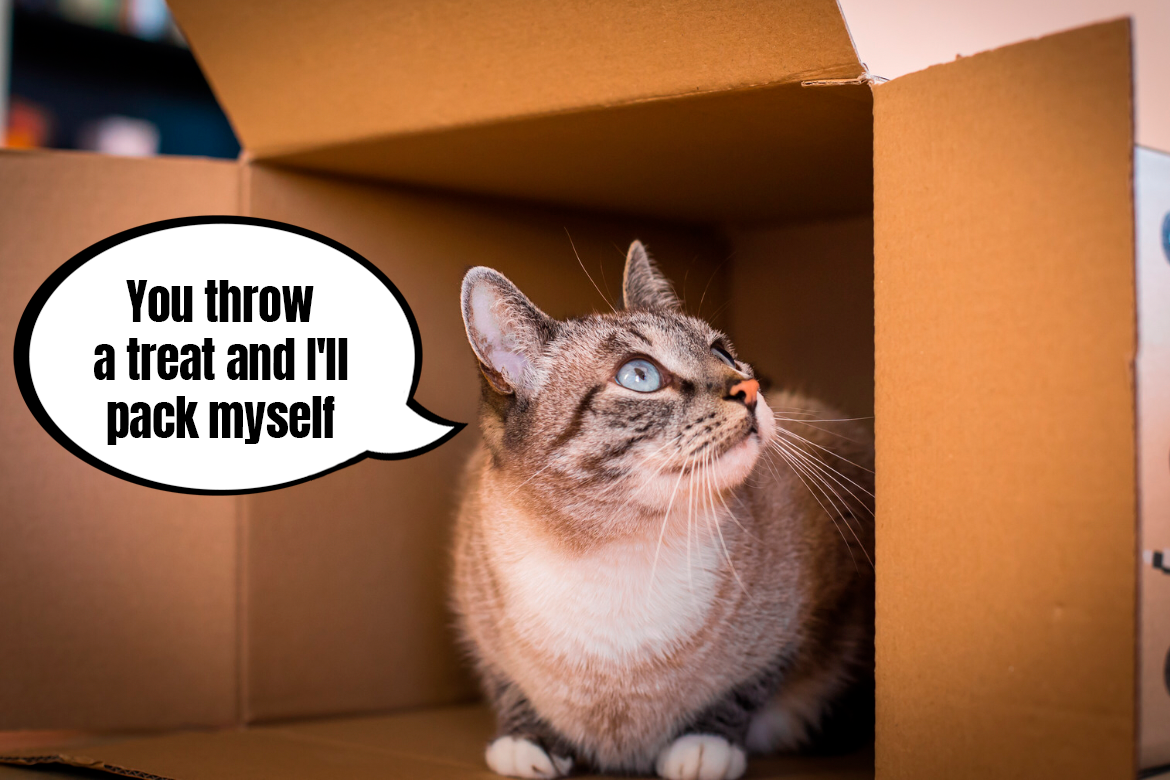First move with cats in myKotty team? It was pure chaos. Floof everywhere, boxes occupied by cats and the recurring question in our heads “where do we fit it all?” From the cat Guardian’s perspective, our fluffy companions are like kids to us – regardless of their age, we’re always trying to provide our cats a stress-free life. In the case of moving out, we ourselves are often so stressed out that it impacts our cats as well.
Every kitten will come across situations that put them in a difficult spot and cause stress. Moving to a new place is definitely high up on the list. Changing the meowddress is an unexpected and sudden experience for any cat – it takes them out of their own, safe environment and puts them into a new, unknown space. How can we prepare ourselves, our new floofy companion and the resident cats for a move?
Kitten on board – get ready to bring a cat baby home
Today in Poland we’re celebrating Children’s Day, which is why we can’t help but start with the first and most important move in any kitten’s life. Going away from the breeders, the warm care of a cat mom, her floofy coat and the frolicking siblings to some new and unknown hooman’s house is a big challenge for a tiny kitten. It’s equally as difficult for cats who’ve been born outside and have to adjust to a life with hoomans, regardless of the stage of their life. How can we, as Guardians, make it easier for cats during their first move?
- A safe cat corner
Behaviorists recommend for a new kitten in the house to have access to only one room at first, e.g. your bedroom. By putting every necessary resource there – the litter box, food bowls, scratchers, cat beds and toys – we’re giving the youngster time to get accustomed with our scents and the surroundings and to build a sense of security in this one, small space. It’s just like us, hoomans – we never feel “at home” in a new place right away. Once you start broadening the kitty’s territory, the bedroom will become their safe haven if there’s too much happening at any point of the day.
- Slow introduction to the new territory and resources
The process of introducing a cat to the entire new house can take from a few hours to a few days or weeks. Let’s allow the kitten their own pace by setting up one, safe base and opening up the rest of the house slowly, for them to freely explore as they wish. Forcing a cat to leave their comfort zone is risky, but fortunately cats are quite clever beasts – brave when facing the new world, so they quite quickly decide to explore the world. If they happen to do so, let’s make sure they have necessary resources around the house. With time, some of those will “move out” of the bedroom 🙂
- Time to get to know the hoomans
Similarly to getting accustomed with a new territory, kittens need time and space to get used to people. They won’t immediately leave fluff on all your sweatshirts and fabCat t-shirts. Looking for company and support, they will eventually make the decision to come to you. Bonus: if a kitten doesn’t feel troubled by the hoomans and choses to get closer, they’ll be much more likely to trust us and build a strong, lasting relationship with us. Thinking about it a little bit more, we wouldn’t want a giant human picking us up in an unknown space either.
- Proper socialization with resident cats
Cat introductions when bringing a new cat into a house with already established resident cats seems to be the hardest step for many cat Guardians. The risk of “cat fights’ is quite high. It’s good to take it slowly and with caution, using the help of socialization with isolation. We ourselves used it when we brought home our two boys: Kitku Yoda and, a month later, Teddy and introduced them to our resident Figo. Patience is key and thanks to giving our cats time and space to safely get to know each other, the environment and us, our entire family gained a lot from the experience. You can read more about this method in one of our previous blog posts.
Cat “moving day” necessities
Kittens don’t need much to start with, especially when they’re still getting used to new surroundings and new people. A fluffed up blanket taken from their previous home, a cat dining space, a litter box and a good quality scratcher is a great set for the first days – after all, as new cat Guardians, we’re not sure yet what the cat will like. We have prepared a handy checklist of all cat’s necessities before, but just as a reminder, we recommend getting:
- A good quality, hard transport case. Even though softer cat bags and wicker baskets are very popular, a hard transport crate that gives you the ability to secure it with a safety belt or to take down the hood during a vet visit is much more practical and safer for the cat. For comfort’s sake, put a soft blanket inside.
A good idea here is using a blanket, which the kitten has taken from their breeder’s house or the foster home. It’s familiar and loved, so by bringing smells that are known to the cat with them we’re building a sense of security in the process.
- Prepare the kitten’s favorite food. By asking the previous Carer/breeder about the cat’s preferences you can make sure that once they arrive at your home, they’ll gladly dig into their food bowl. Eating in a new environment is the best sign from a cat that they feel secure enough. Pawsome!
- Set up the litter box in an easily accessible spot. The litter box shouldn’t be hidden in a corner, a tough-to-get-to spot of the house or a bathroom that could be accidentally closed, cutting off the cat’s access to his basic resource. For the first few days, put the litter box where it’s easy to get to for the kitten. If it’s a relatively small litter box, remember to size it up as they grow so they will always be able to freely move around inside. It’s like with a hooman and a potty 🙂
After moving to a new place, your cat will obviously need scratchers, toys and cat beds. We recommend setting them up prior to bringing the cat home, so that it soaks in all the scents of the house and can serve the cat as his own road signs around the new territory.
Changing a cat’s territory – low-stress move
Moving stress is a concern not only for small kittens going to their forever homes. At some point of a cat’s life there might be surprises waiting even for the adult resident cats, for whom getting ready to pack things up into a box and leaving a trusted environment behind is not an easy task. For those instances, we have some tricks up our sleeve:
For the packing up portion of the move, e.g. putting everything into boxes, getting visits from strangers and the moving company working their way through the house, your kitty might feel better being enclosed in a one, smaller room of the house that’s not being moved until the very end. All their necessary resources should go into the bedroom or the home office, giving your cat a sense of security. The bedroom might be your best choice, as we – hoomans, move out of the bedroom at the last moment anyways. As a bonus, enclosing a cat in your bedroom gives you certainty that the kitty won’t leave the house with the moving team.
For cats who don’t know or necessarily love car rides, the actual move to the new house will be another stressful point of the journey – barfs may happen on the way every few kilometres. Depending on the length of the car ride, it’s a good idea to get a cat used to such trips slowly and reward them for good behaviour. We should also accustom them to the transport crate/box and getting locked up inside as well. If possible, it’s better for one Guardian to sit with the cat in the back seat – the kitty will see you and feel your support.
A new house means a new territory, full of foreign smells and noise that goes along with the unpacking process. And no cat floof! Again here, a good solution will be to slowly introduce a kitty to the new place and create a small, enclosed space for them for the beginning. With highly stressed cats it’s advisable to use synthetic cat pheromones and spray them in the new house a few days before the move. That way, getting into the new place should go much smoother.
Not all cats are created the same
To end the topic, let’s admit that all cats are different and every single one of them can, in different stages of their life, react unexpectedly to the move, to the surprise of their Guardians. Huge amounts of stress, lack of appetite, behavioral problems or health issues are some elements that we, as Guardians, should be aware of and look out for when moving with a cat.
For many meowing friends, move will be but a formality – a new territory to take over, floof over and claim as their own. We have to remember though that after the first burst of curiosity, your cat can meow for a few days, wander aimlessly and complain, missing their old digs. And that’s purrfectly fine. It’ll pass with time. Time, love and care from the Guardian are the best medicine for a cat in this case.
Time for your fabCatstic moving stories. Were they successful? How often did you have to pull your cats out of the boxes before putting another layer of plates, mugs and cat fur in? We’re waiting for your stories in the comments and sending fabCat energy to everypawdy who’s just now getting ready for a cat-filled move. Good luck!




